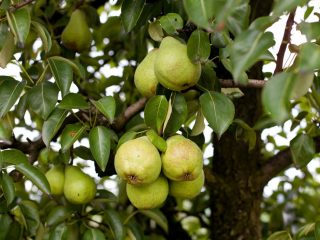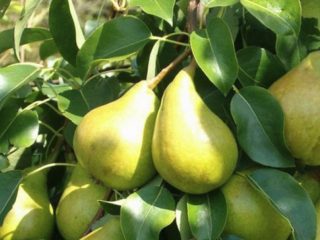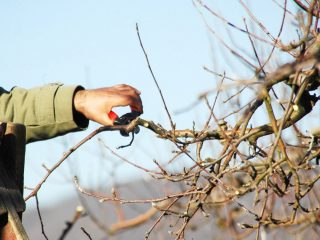Content
Aphids on pear trees are a problem that is familiar firsthand to almost all gardeners who have these trees on their plots. A pest that feeds on plant sap greatly weakens its immunity, which negatively affects cold resistance and overall endurance. To combat insects, you can use both chemicals and folk remedies.
Description of aphids with photo
Aphid (Aphidoidea) is a small (up to 3 mm) cephalopod, wingless insect from the category of piercing-sucking insects. Depending on the variety, it can be almost transparent, pale green, reddish, dark brown, or black. It does not have a durable chitinous shell; in fact, it is a “vessel” filled with plant sap of a tree.

Aphid on a pear: description of the insect and its varieties, symptoms of damage, damage caused to plantings.How to get rid of the pest and prevent it from attacking trees.
Unlike most insects, aphids bypass one of the intermediate stages of development (“pupa”). From eggs overwintering in the soil or in cracks formed as a result of microdamages on the bark of trees and shrubs, larvae emerge and develop into adults.
For the garden, aphids are one of the most dangerous pests. She is distinguished by her gluttony and “omnivorousness”. Insects can attack almost any ornamental or fruit-bearing plant.

Aphids reproduce very actively - each female lays 60 eggs up to 16 times during the season.
In late July or early August, winged females hatch from the eggs. This is a special form of aphid, “designed” to expand the habitat of the colony by flying to neighboring plants. A little later, winged males appear. At the end of summer, insects mate, females lay eggs, ensuring the reproduction of offspring for the next season.
Types of aphids on pear
Pear trees are attacked by different types of aphids. In this family of insects there are both monophages that feed on the sap of these particular trees, and “omnivorous” representatives that do not distinguish between garden crops.
Gall aphid on a pear
Gall aphids are also called leaf rollers. These small black insects concentrate on the undersides of young leaves.

Pear leaves affected by gall aphids curl into tubes and quickly dry out.
Red gall aphid
Also known to gardeners as “blood”. Settles on any fruit trees. A colony of red gall aphids looks like a ball of cotton wool. The body of each individual is covered with whitish “lint”. It owes its nickname to the fact that when an insect is crushed, a reddish liquid is released.

Compared to other types of insects, the red gall aphid is more capricious and prefers a mild, warm climate.
Green aphids on pear leaves
There are the rather rare green pear-umbrella aphid, which is a specific pest of pears, and the very common “ordinary” one, which attacks any garden crops. Externally, the insects are no different, except for color.

The “simple” aphid on the pear is pale, light green in color; the pear-umbrella aphid has a brighter shade, close to lime.
Why do aphids appear on pears?
Often, insects appear on a tree “spontaneously”, flying from neighboring garden plots or wild plants in search of food. They are also “bred” by ants, with whom they form a stable symbiosis. If there are several anthills on the site, if nothing is done, sooner or later the aphids will “spread” over it.
The gardener himself can “bring” the insect to the fruit tree. Most often this happens when soil in which aphid eggs have successfully overwintered is used for planting or replanting a tree. Other possible ways are to place contaminated plant debris in a compost heap or “storage” it on a personal plot instead of immediately destroying it.

Due to their small size, aphids cannot move far enough, but sometimes a few meters are enough
What do aphids look like on pear leaves?
Despite their small size, it is difficult not to notice aphids on a tree. The gardener is “helped” by a large number of insects. At first, they stick around parts of the plant in a continuous layer; as the number of the colony increases, if nothing is done, the aphids turn into something similar to “clusters”.

As aphids spread throughout the pear, they gradually concentrate on the most tender and juicy tissues
What harm does
If aphids are not controlled, the pest can lead to the death of the tree in 2-3 seasons. Together with the juice, the insect “pulls out” the nutrients necessary for normal development and functioning.
As a result, the pear practically stops growing and bearing fruit, the shoots become severely bent, and small and deformed leaves fall off much earlier than expected. Those fruits that do set and ripen are noticeably inferior in appearance, size and taste to specimens taken from healthy trees.

The cold resistance and general endurance of an aphid-affected pear drop greatly, and it gradually dries out.
The waste product of aphids is a sticky whitish or translucent coating. It gradually becomes covered with a layer of sooty fungus, preventing normal gas exchange and photosynthesis. In addition, this is a very suitable environment for the proliferation of any pathogenic microflora. And the punctures left by insects on leaves, flowers, and buds are ready-made “gates” for infections. Often, pathogens are carried by aphids themselves.
How to get rid of aphids on a pear tree
It is quite possible to save a pear from aphids. Even folk remedies can help in the early stages of insect infestation.But when time is lost, and the number of colonies on the tree has grown greatly, there is no need to aggravate the problem further. It is necessary to use insecticides of chemical and biological origin.
Chemicals
The main advantage of chemicals is their high efficiency. However, when working with them, you must strictly follow the instructions given in the instructions. Many of them are dangerous not only for harmful insects, but also for human health, domestic animals, and the environment. Such preparations cannot be used to treat pears against aphids during fruiting and flowering.
Kinmiks
An enteric-contact insecticide based on beta-cypermethrin, which effectively destroys both the flying form of aphids and insect larvae. Penetrating into the pest's body, it causes instant paralysis. The effect of the treatment lasts for 2-3 weeks.

Pears can be sprayed with Kinmiks no later than 20 days before harvest
Confidor-Maxi
Systemic insecticide against any sucking and gnawing insects. The active ingredient is imidacloprid. Acts on aphids as a neurotoxin. Protects against insects for 15-30 days, starts working 1.5-2 hours after treatment. Most effective at temperatures of 12-25 °C.
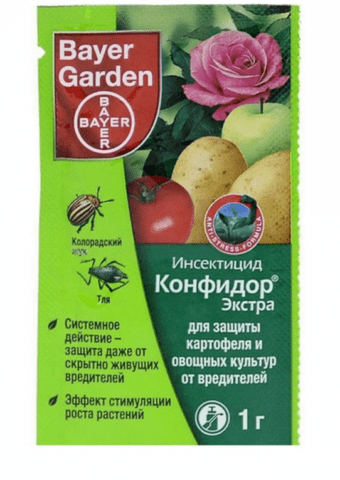
Confidor-Maxi has an “anti-stress” effect on pears, “neutralizing” the negative influence of environmental factors
Aktara
A drug based on thiamethoxam. The aphids poisoned by it are unable to feed within half an hour and quickly die of hunger. The insecticide is safe for humans, domestic animals, and soil fauna. Provides pears with protection from aphids for 15-30 days.
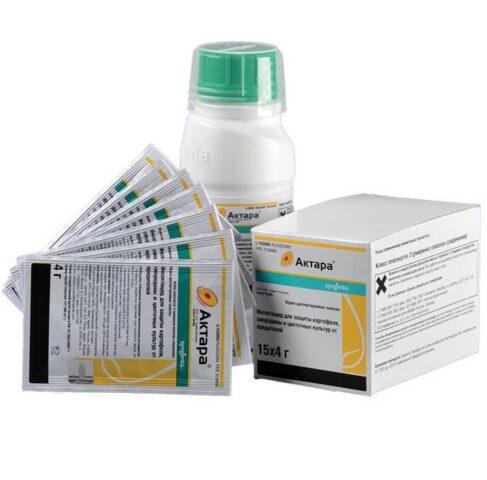
Aktara is available in different forms and volumes, which is very convenient for gardeners
Biological preparations for aphids on pear
Unlike chemicals, biological products can be used to treat pears against aphids at any time - after flowering, before it, shortly before harvest. However, they do not begin to act immediately and are almost completely washed away by rain.
Aktofit
A biological product based on the natural neurotoxin – aversectin-C. Available in the form of a liquid concentrate, in different volumes. It is not recommended to treat pears with it during flowering - bees and other beneficial insects may be harmed. The tree is harvested five days after spraying.

Actofit is ineffective against aphid eggs, so the pear will have to be sprayed 2-3 times with an interval of 12-15 days
Fitoverm
At the same time a bioinsecticide and fertilizer for pears based on bitoxybacillin. Effective against any sucking insects. Treatment of wood against aphids must be carried out twice, with an interval of 15 days. The drug begins to act after three days, the protective effect lasts for 20 days.
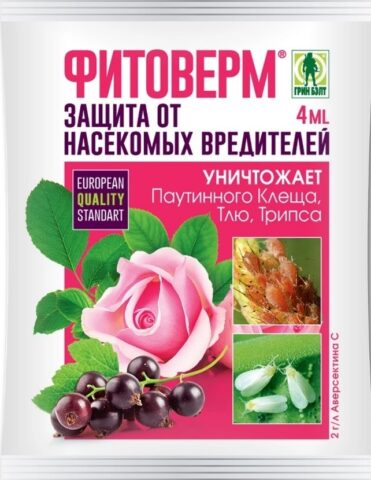
The effectiveness of Fitoverm decreases noticeably in heavy rain and temperatures above 30 °C.
Spark
The drug is available in two versions, both are equally effective against aphids on pears. The active ingredient of Iskra Double effect is plant alkaloids, Golden is an extract of tobacco leaves.

The spark provides pears with protection from aphids even in extreme heat.
Folk remedies for aphids on pear
A significant advantage of folk remedies is the ability to use them at any time. They will not harm if you treat a flowering or fruiting pear tree against aphids. But they are practically useless if there are a lot of insects on the tree.
How can you treat a pear on which white aphids and its other varieties have settled:
- Any strong-smelling infusions. The insect does not like strong odors.As “raw materials” you can use onion and garlic “feathers”, citrus peels, pine needles, tomato and potato tops, wormwood, tansy, and marigolds. You can add hot pepper, mustard powder, tobacco crumbs.
- Fermented milk products (kefir, whey, yogurt). Aphids are unable to digest the milk sugar they contain. The drink is diluted with water in a ratio of 1:3.
- Lather. Laundry, tar or green potassium soap is rubbed on a fine grater. Beat the shavings in warm water (approximately 40 g per 10 l).

When the foam comes into contact with an aphid, the fats contained in the soap “envelop” it, preventing it from breathing
How to protect a pear from aphids
Preventing an aphid attack on a pear tree is easier than trying to get rid of a colony of insects later. Competent prevention for trees includes:
- Quality care.
- Spray with insecticides several times during the season. The pear must be treated against aphids on it before flowering and in preparation for winter.
- Mandatory deep loosening of the tree trunk circle in the fall after clearing of any debris.
- Whitewashing a tree trunk and skeletal branches to destroy egg clutches.
- Targeted control of ants, especially if the anthills are located near the pear.
- Sanitary pruning twice a year.

Each ladybug eats approximately 200 aphids daily
Varieties resistant to aphids
There are no varieties of pears that are resistant specifically to aphids.As a rule, this property “comes along” with the general endurance of the trees, high frost resistance and good immunity.
August dew
Pear up to 3 m high, thickened crown, drooping shoots. The fruit weighs about 130 g, the skin is dull green. The pulp is very tender and juicy, the taste is balanced, sweet and sour. The variety is early-bearing (in the fourth year), harvests are annual.

The August dew pear ripens in August and is stored for a maximum of two weeks.
In memory of Yakovlev
Low-growing early autumn pear with a rounded crown of medium density. The weight of the fruit is in the range of 150-200 g, the skin is thin, pale yellow, with a pinkish “blush”. The pulp is creamy-white, oily, very juicy and sweet, without the slightest astringency.

Memory Yakovlev pear is used in breeding for breeding varieties resistant to severe frosts
Severyanka
Not too tall early summer pear with a wide pyramidal crown of medium density. The fruits are small and varied in size. The skin is yellow-green, with a dull “blush”. The pulp is creamy, not too dense, the taste is sour, without astringency.

The main disadvantage of the Severyanka pear variety is that ripe fruits quickly fall off the branches.
Conclusion
Aphids on pears are a fairly typical problem for this fruit tree. Massively attacking pests feed on plant sap, causing tissue death. If nothing is done, the tree will die within 2-3 seasons due to a decrease in overall immunity and endurance. Folk remedies and insecticides will help you cope with aphids; we must not forget about preventive measures to prevent insect attacks.



